Which exercises are best to treat climbers’ elbow depends on the origin of your pain. Because not all pain that is defined as a climber’s elbow has its origin on the inside of the elbow. The pain can also be caused by a segmental dysfunction in the neck, movement dysfunction or shoulder hypertension, or something similar in the hand.
Still, if you do have a climber’s elbow with the origin of your pain being on the inside of your elbow the best exercises are stretching, self-massage, mobility exercises, and strength exercises focused on eccentrics. Then, when the irritation reduces you can start a more intensive loading program focused on climbing-specific moves and exercises.
In this blog, I’ll tell you which exercises you can do depending on the type of climber’s elbow you are suffering from. Because yes, also if your pain is originating from the elbow itself there is still a variety of structures that can cause it. I’ll start by explaining in more depth the character of a climber’s elbow and will then discuss other problems that can have similar symptoms.
Let’s start right away.
1. What is a Climbers Elbow?
Climbers elbow is known within the medical literature as medial epicondylitis, an inflammation of the medial epicondyle, and is also known as a golfer’s elbow.
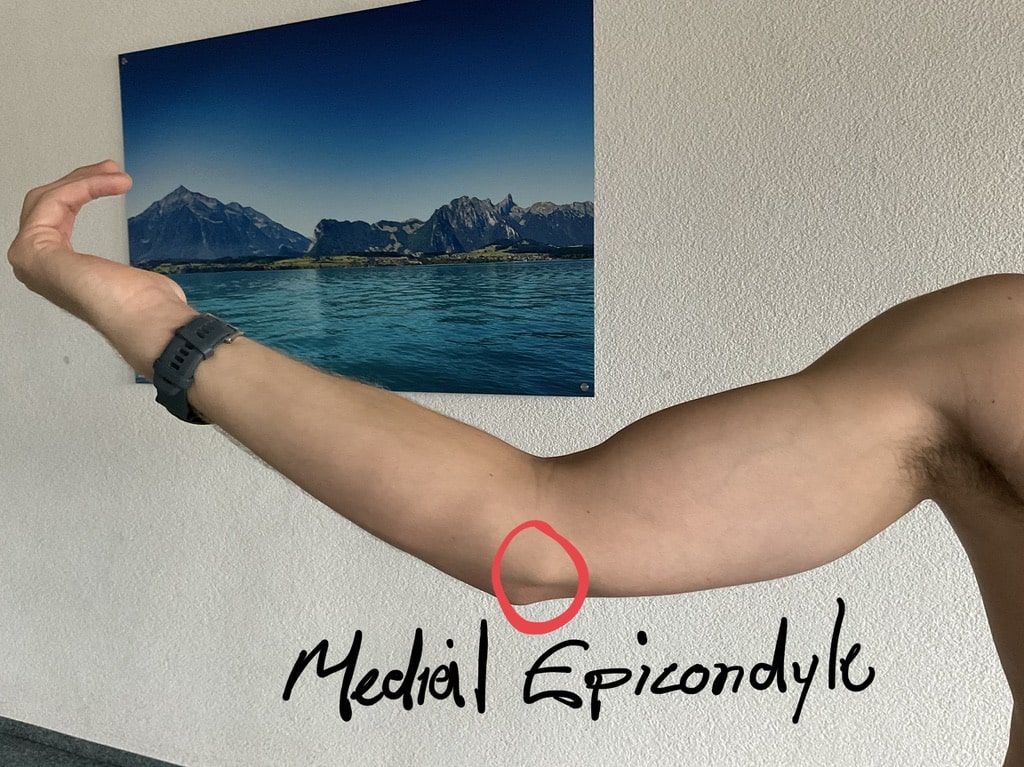
The medial epicondyle is a bony structure at the medial end of your upper arm bone and is the origin of many forearm muscles. These bend the wrist, and fingers, and pronate the lower arm. All of them are used intensively while rock climbing and are therefore prone to overuse.
An overload of these muscles often leads to hypertension and then to problems in the tendons that connect the muscles to the medial epicondyle. Tendons are slow to respond to load and thus only start hurting days to a couple of weeks after you started overloading. This means that this overload has a cascading effect. Because you didn’t just overload for a day but all the days until you started noticing it. If you analyze your training plan, you’ll usually find the origin of your overuse quickly. Did you change anything about your training? For example, the frequency, intensity, training time, type of routes, or type of projects? Or are you experiencing heightened stress levels, sleeping less, working more, or anything else in that category?
All these factors can increase the chance of overuse. Even more so, if you consider that many of you have office jobs that require you to use your forearm flexors all the time while typing and using the mouse at your computer.
So, a golfer’s elbow is usually described as and considered to be either medial epicondylitis or medial tendinopathy or tendinitis in the elbow.
2. Origins of Typical Climber’s Elbow
If the origin of your climber’s elbow pain is in the elbow itself it’s most likely the osotendinous junction (OTJ), the tendon, or the myotendinous junction (MTJ) where the irritation or inflammation can be found. And then of the following muscles:
- Flexor Digitorum Superficialis: bends the wrist and the first two digits of the 2nd to 5th finger
- Pronator Teres: pronates the lower arm which is the movement you make when emptying a bottle of water
- Flexor Carpi Radialis: bends the wrist and radially deviates it
- Palmaris Longus: bends the wrist and tenses the palmar aponeurosis (a connective tissue sheet)
- Flexor Carpi Ulnaris: bends the wrist and deviates to ulnar
And since all these muscles have their origin on the humerus, they also help to flex the elbow.
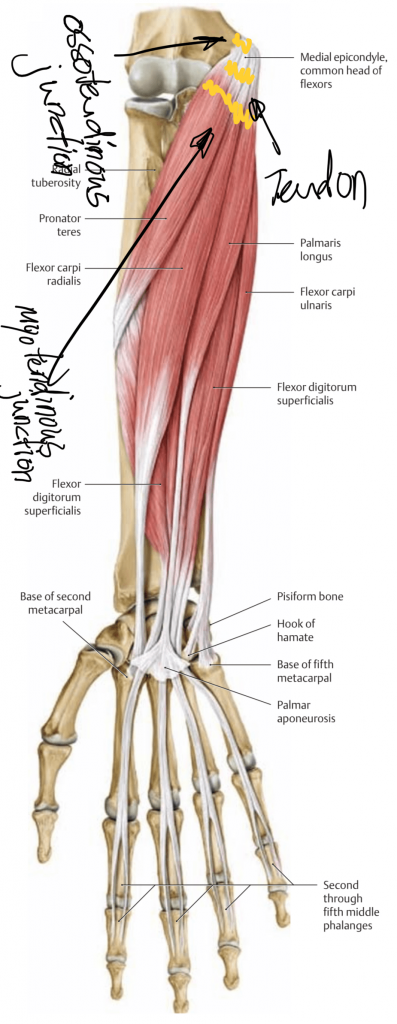
So, these can be the muscles and tendons that cause your medial epicondylitis. But how do you know which one is the origin of your pain? Could you feel your elbow to figure that out?
It’s unlikely you’ll figure this out by palpating the elbow. It’s such a small area and there are 5 muscles connecting to it.
Thus, the easiest way to go is by doing stretch and resistance tests. Stretching the muscle will lengthen it which can provoke pain in an irritated tendon, which is also the case for activating it.
First, you stretch the muscle entirely and then try to use it from a lengthened position. Why from a lengthened position? Because that’s where the muscle is weakest and most likely to get provoked quicker.
Here’s how you stretch and activate, and thus provocate if they’re painful, the muscles described above.
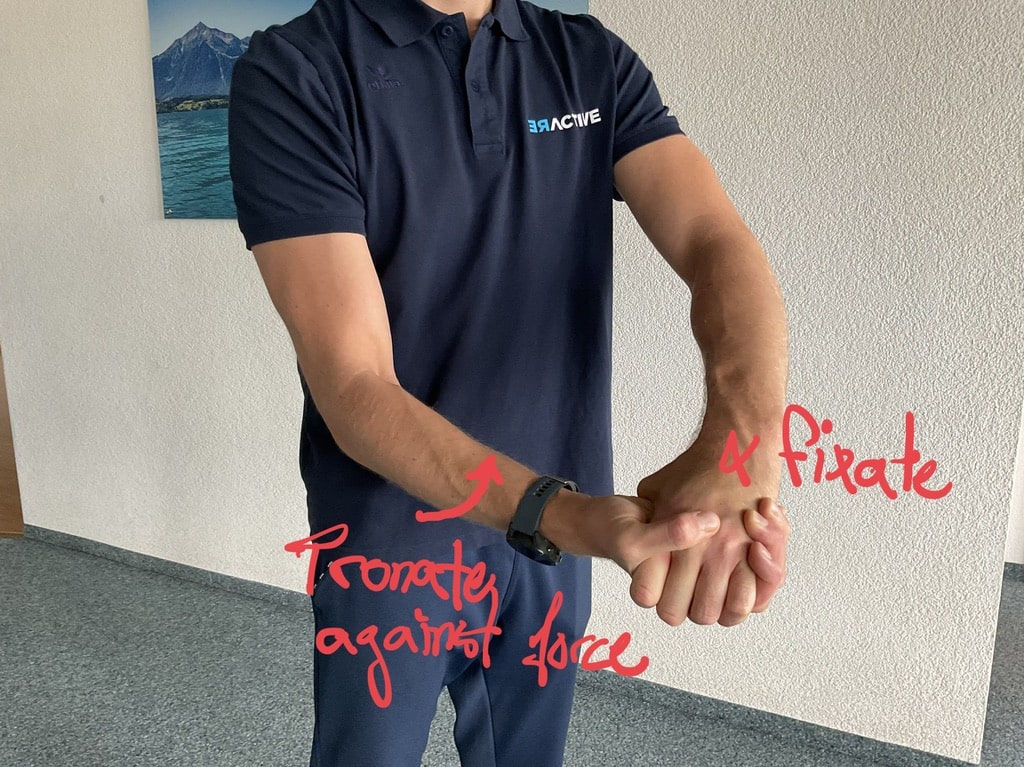
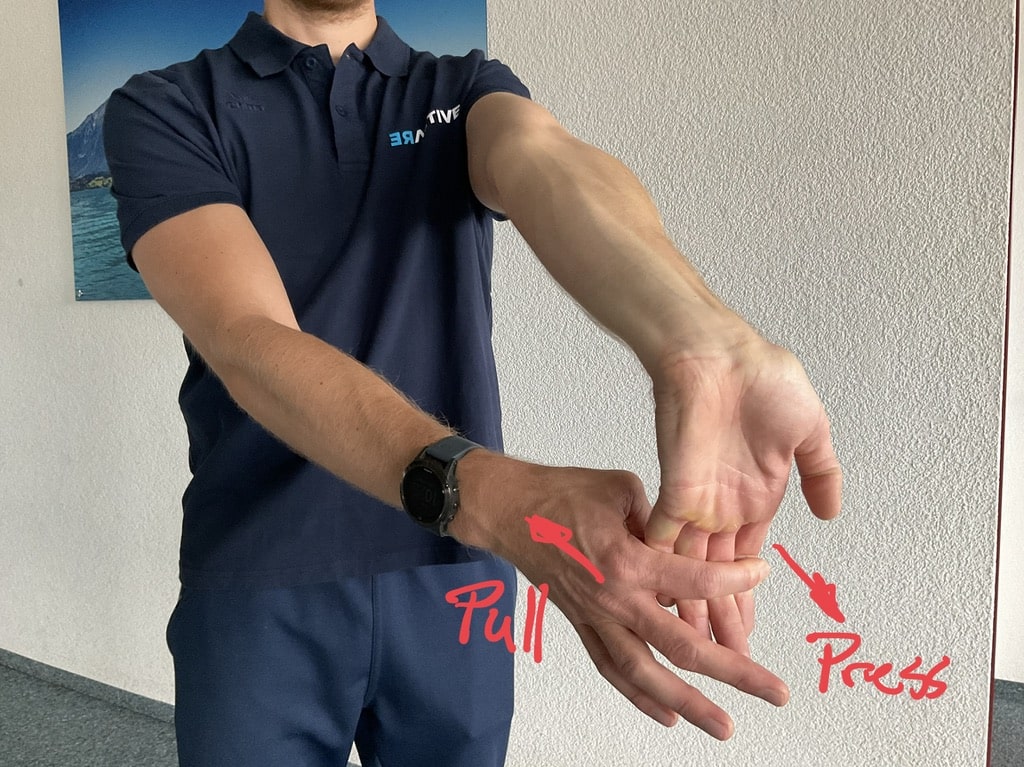
3. Other Problems That Can Cause Climber’s Elbow Type of Pain
It is not unlikely that your climber’s elbow is the result of a problem somewhere else than in the tendons of the muscles I discussed above. Or, what I see often, is that it’s a combination of deficiencies.
Here’s an overview of the other structures that can cause medial elbow pain and how to diagnose them:
- Capsule: you’ll have a difference in range of motion between your pain-free and your painful elbow. It’s not possible to bend, extend, pronate, or supinate your elbow all the way.
- Trigger Points in the pectoralis major: trigger points in de large chest muscle can cause pain in the medial elbow. In these blogs, you can read more about trigger points; Trigger point therapy for rock climbers and self-myofascial release for rock climbers.
- Trigger Points in the underarm flexors: same as the pectoralis major, trigger points in these muscles can cause medial elbow pain
- Carpal Tunnel Syndrome (CTS): entrapment of the median nerve in the carpal tunnel can cause pain along the path of the median nerve, which passes by the medial elbow. You can read more about CTS in these 2 blogs: How to rehab after carpal tunnel syndrome surgery and the fastest way to heal carpal tunnel syndrome.
- Movement Deficiencies in the Shoulder or Skapula: insufficient coordination, mobility, or stability can irritate the medial elbow. Regardless of whether I’ve found the origin of your climber’s elbow to be in your elbow or not, I’ll always check your shoulder and scapula. Since issues, there might have caused the tendon in the medial elbow to overload faster.
- Tendon tear: if you had an acute injury resulting in medial elbow pain it might be that a tendon attached to the medial epicondyle is (partially) torn. This requires a different rehab than a tendinopathy
- Neurological Pain: compression of the nerve roots C8 and T1 can cause radiating pain in the medial elbow.
- Segmental Dysfunction in the Neck: a movement dysfunction in the facet joints (the joints between individual vertebrae) doesn’t necessarily cause compression of the nerve roots but can still provoke problems in the areas they supply. I would expect issues with C7 or T1.
Are you sure, after reading here, that your climber’s elbow pain is either entirely or partially due to tendinopathy in the forearm flexor tendons?
Then read on to discover which exercises are best for each of the muscles.
4. The Best Exercises for Climber’s Elbow
I divide the exercises by stages of irritability. These are the stages:
- Pain at rest
- Pain during an unloaded range of motion
- Pain with easy activities like stretching or light resistance exercises
- Pain with heavy activities like bouldering, crimping, weight lifting, or campus boarding
The stages as well as the training intensity are the same for each muscle. Only the exercises will vary. You can progress to the next stage if your irritability has reduced accordingly. Obviously, there’s progress within the stages too. If you can progress to stage 4 doesn’t mean you should start projecting boulders and doing crazy campus moves. No, you start with light easy climbing and hang boarding on easy holds and progress from there.
Below I show the best exercises and what they look like for each of the muscles. I grouped the flexor carpi ulnaris, flexor carpi radialis, and palmaris longus because they’re all mainly wrist benders.
Best Exercises for Irritability Stage 1
- No sports, no other activities as described below
- Evade irritation as much as possible
- Active Range of Motion within pain limits
- Relaxation/Massage/Friction of affected muscles
- Kinesiotape along affected muscles to reduce load
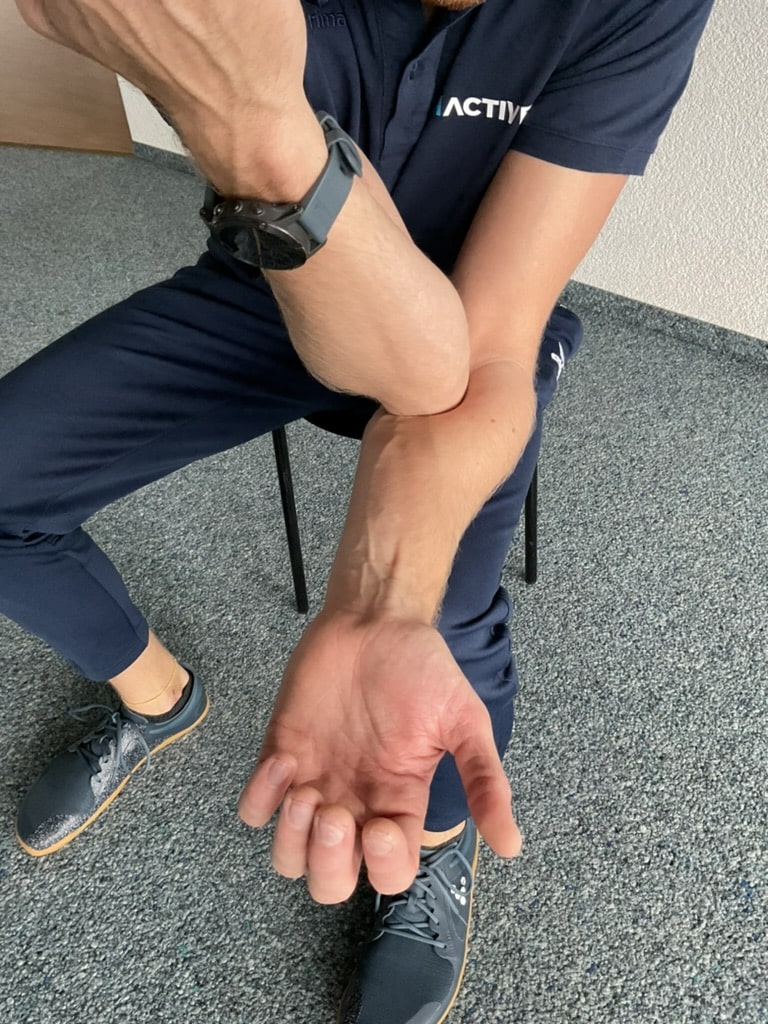
Irritability Stage 2
Pain intensity of 3/10 allowed during activity.
- Stretch affected muscle
- Eccentrics
- Isometrics
Irritability Stage 3
Pain intensity of 5/10 allowed during activity.
- Concentric/Eccentrics
- Start Light Finger Boarding (feet on the floor)
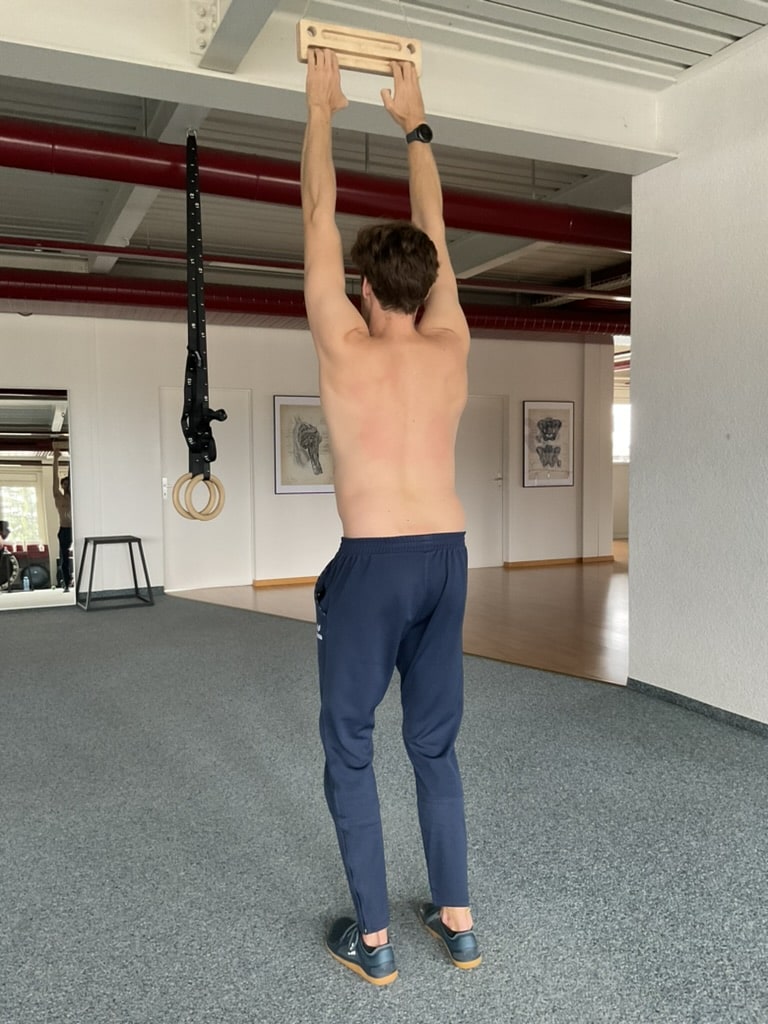
- Stabilization/Coordination of kinetic chain
Irritability Stage 4
- Concentrics/Eccentrics
- Start climbing
- Regular Elbow Strengthening Exercises: TRX Rows, Push-Ups, Scapula Push-up, Kettlebell Windmill
5. Important Takeaways
In my experience, a climber’s elbow is never just a climber’s elbow and should therefore always be considered with the entire kinetic chain in mind. If I analyze functional climbing movements like pulling and hanging, plus the individual joints of the upper extremity for mobility, coordination, and stability issues I usually get a grasp of the root cause of a climber’s elbow quickly. You can do this yourself with the help of a video and a friend. Or of course, with the help of a trained professional.
